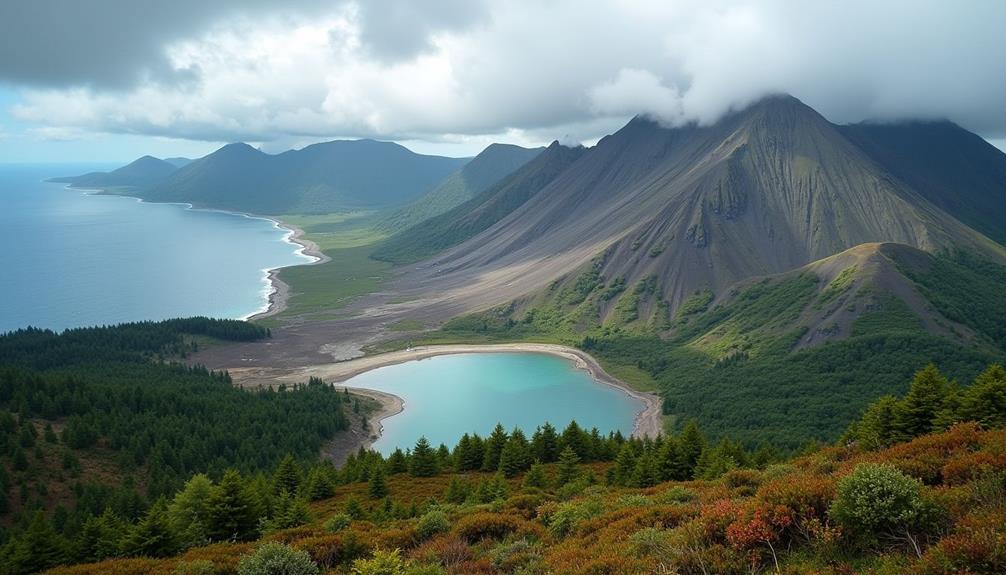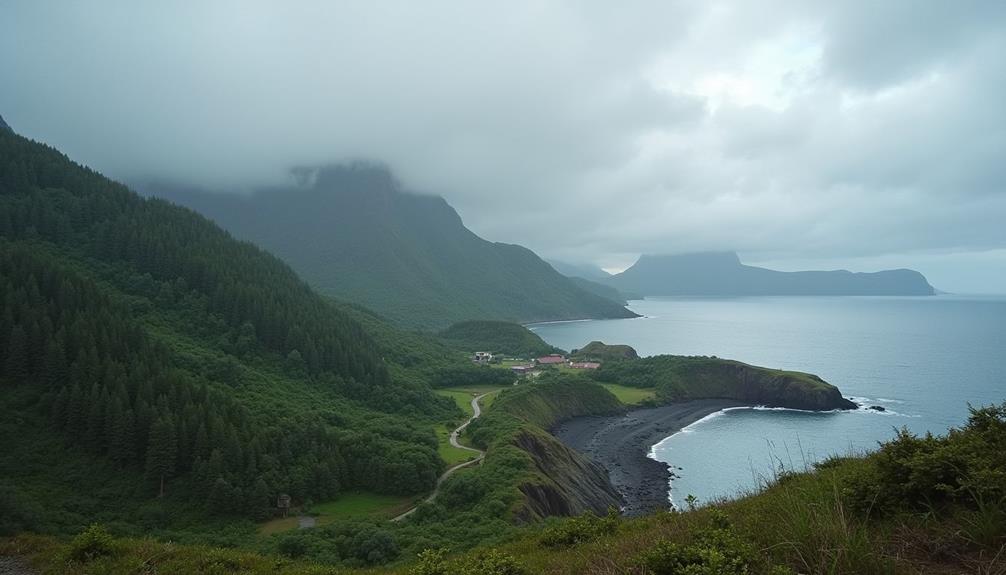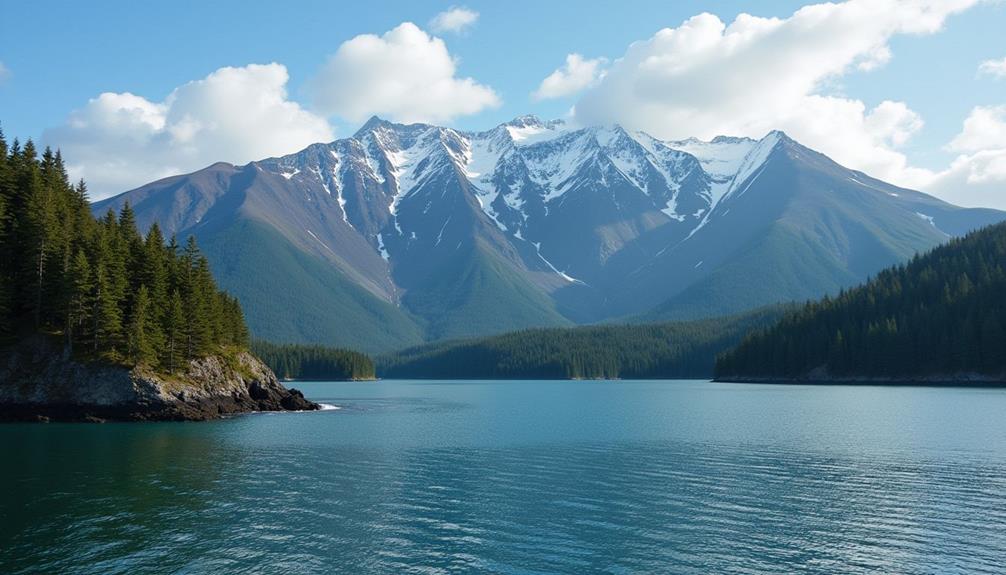The Kuril Islands, an archipelago nestled between Russia and Japan, present a pristine wilderness characterized by striking volcanic landscapes and an abundance of unique wildlife. Hosting over 100 volcanoes, some still active, the islands offer dramatic vistas complemented by thermal springs and rugged coastlines. This remote region is not only a haven for Steller sea lions and migratory birds but also a sanctuary for rare endemic species. Additionally, the area is rich in cultural heritage, embodying the enduring traditions of the indigenous Ainu people. What secrets does this untouched paradise hold for those who venture into its depths?
Volcanic Landscapes

The Kuril Islands, often recognized for their striking natural beauty, are mainly characterized by their volcanic landscapes. This archipelago, stretching between the Russian Kamchatka Peninsula and Japan’s Hokkaido, boasts a series of geological formations that captivate the adventurous spirit. The islands are home to over 100 volcanoes, 40 of which are still active, creating a dramatic and ever-changing panorama. The rugged terrain, punctuated by craters and lava plateaus, reveals the dynamic processes shaping the Earth’s crust.
Explorers seeking solace from urban life will find the Kurils’ thermal springs particularly appealing. These geothermal wonders are scattered across the islands, offering natural hot baths amidst untamed wilderness. The springs, heated by the volcanic activity below, provide a unique opportunity to experience the raw power of the planet while indulging in a moment of relaxation.
The geological formations and thermal springs of the Kuril Islands not only highlight the region’s raw beauty but also invite those yearning for freedom to immerse themselves in an environment where nature reigns supreme.
The synergy between the landscape and geothermal activity fosters a sense of awe, making the Kuril Islands an unparalleled destination for those seeking true escapism.
Diverse Wildlife
Nestled within the Kuril Islands’ rugged landscapes, an astonishing array of diverse wildlife thrives, each species uniquely adapted to the harsh yet bountiful environment. These islands, positioned between the Sea of Okhotsk and the North Pacific Ocean, are home to unique ecosystems that support a rich variety of flora and fauna.
Among the most remarkable inhabitants are the Steller sea lions and northern fur seals, which find refuge along the rocky coastlines.
The Kuril Islands also serve as crucial breeding grounds for numerous seabird species, including tufted puffins and guillemots. These avian populations are supported by the islands’ abundant marine resources, which are integral to their survival.
Migratory patterns of birds such as the whooper swan and various species of geese illustrate the islands’ critical role as a stopover and breeding habitat along the East Asian-Australasian Flyway.
Terrestrial wildlife is equally diverse, with populations of red foxes, voles, and an array of endemic insects that occupy the islands’ forests and meadows.
The interplay between marine and terrestrial ecosystems creates a delicate balance, fostering biodiversity that is both resilient and extraordinary. This intricate tapestry of life underscores the Kuril Islands’ significance as a haven for wildlife.
Historical Significance

The Kuril Islands, an archipelago stretching from Hokkaido to Kamchatka, are not only renowned for their ecological diversity but also for their rich historical significance, intricately linked with the natural environment.
The islands were originally inhabited by the Ainu people, who established a vibrant culture characterized by fishing, hunting, and trade with neighboring regions. The Ainu’s connection to the land and sea laid the foundation for the islands’ historical narrative.
In the 17th century, the Kuril Islands became a focal point for exploration. Russian explorers embarked on ambitious voyages, leading to the initial mapping of the archipelago. This era marked the beginning of Russia’s interest in the Pacific region, showcasing the islands as crucial waypoints in maritime navigation.
Notably, the Treaty of Shimoda, signed in 1855, was a significant milestone in the islands’ history. This treaty delineated borders between Japan and Russia, granting Japan control over the southernmost islands while recognizing Russian claims to the remainder of the archipelago. This agreement highlighted the islands’ role in fostering diplomatic relations and international cooperation.
The Kuril Islands also served as a backdrop for various cultural exchanges and interactions among indigenous peoples, explorers, and settlers. The presence of diverse cultures contributed to a rich tapestry of traditions and practices, reflecting the islands’ historical importance as a meeting point of different civilizations.
Today, the Kuril Islands stand as a testament to the interplay of history and geography, embodying the enduring legacy of human occupation and exploration. Their unique cultural heritage and ecological treasures continue to inspire interest and admiration, making them a significant area of study and appreciation in the broader context of history and environmental conservation.
Indigenous Cultures
Indigenous cultures of the Kuril Islands offer a fascinating glimpse into the rich tapestry of human history and adaptation in this remote archipelago. The Ainu, an indigenous people with a profound connection to these islands, demonstrate an enduring legacy of resilience and cultural richness.
Ainu traditions, deeply rooted in the natural world, showcase a symbiotic relationship with their environment, encompassing unique practices in fishing, hunting, and spiritual rituals.
Cultural preservation remains a cornerstone for the Ainu, as they endeavor to maintain their identity amidst the pressures of modernity. Efforts to revive and sustain their language, crafts, and customs are essential in safeguarding their heritage.
Festivals, storytelling, and traditional ceremonies serve not only as a means of cultural expression but also as significant acts of resistance against cultural erosion.
For those who cherish the freedom to explore diverse cultures, the Kuril Islands present an opportunity to witness the living history of the Ainu people. Engaging with their traditions offers profound insights into how humanity can harmonize with nature.
In this way, the Ainu’s enduring presence on the Kuril Islands stands as a reflection of the power of cultural preservation.
Outdoor Adventures

Offering a plethora of outdoor adventures, the Kuril Islands entice explorers with their rugged landscapes and untamed beauty. This archipelago, nestled between Russia and Japan, is a haven for those seeking an unspoiled wilderness.
Enthusiasts of hiking will find a network of hiking trails that traverse volcanic terrains, dense forests, and dramatic coastlines. Each trail offers not only physical challenges but also the opportunity to witness rare wildlife and breathtaking vistas, making every step a discovery.
For those drawn to the water, the Kuril Islands’ kayaking excursions provide an unparalleled experience. Steering through pristine waters, adventurers can explore hidden coves, isolated beaches, and sea caves that are otherwise inaccessible.
The islands’ unique position in the Pacific Ring of Fire means kayakers might even paddle past steaming volcanic vents, adding a thrilling element to their journey.
Whether trekking through untouched landscapes or paddling along the rugged coast, the Kuril Islands offer an escape from the confines of modern life. This is a place where the spirit of adventure thrives, inviting those with a passion for the great outdoors to immerse themselves fully in its raw and unbridled beauty.




